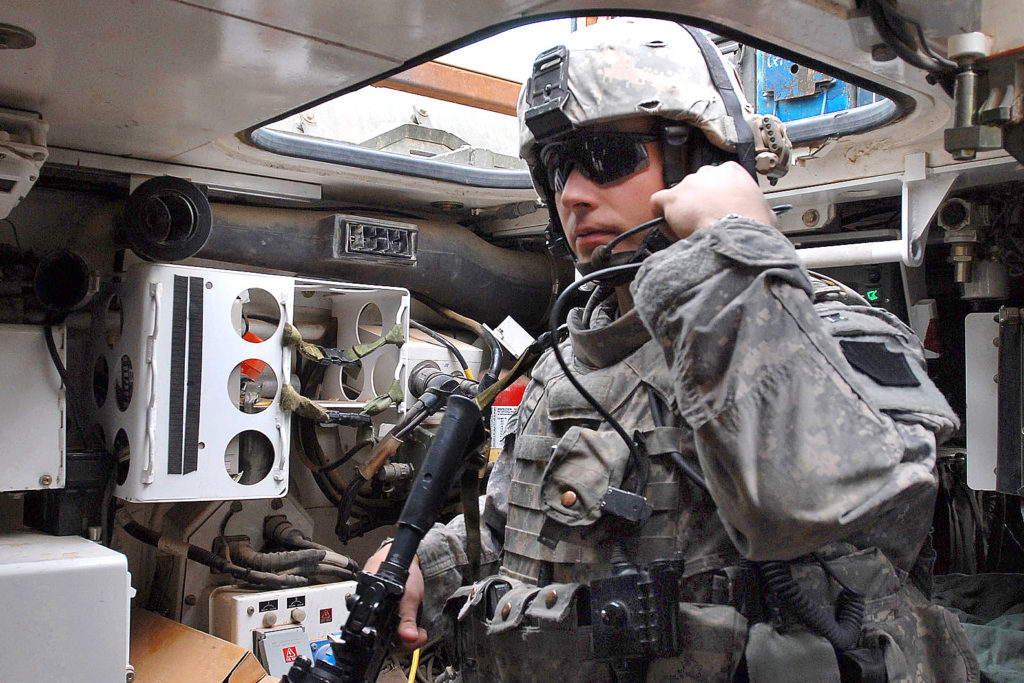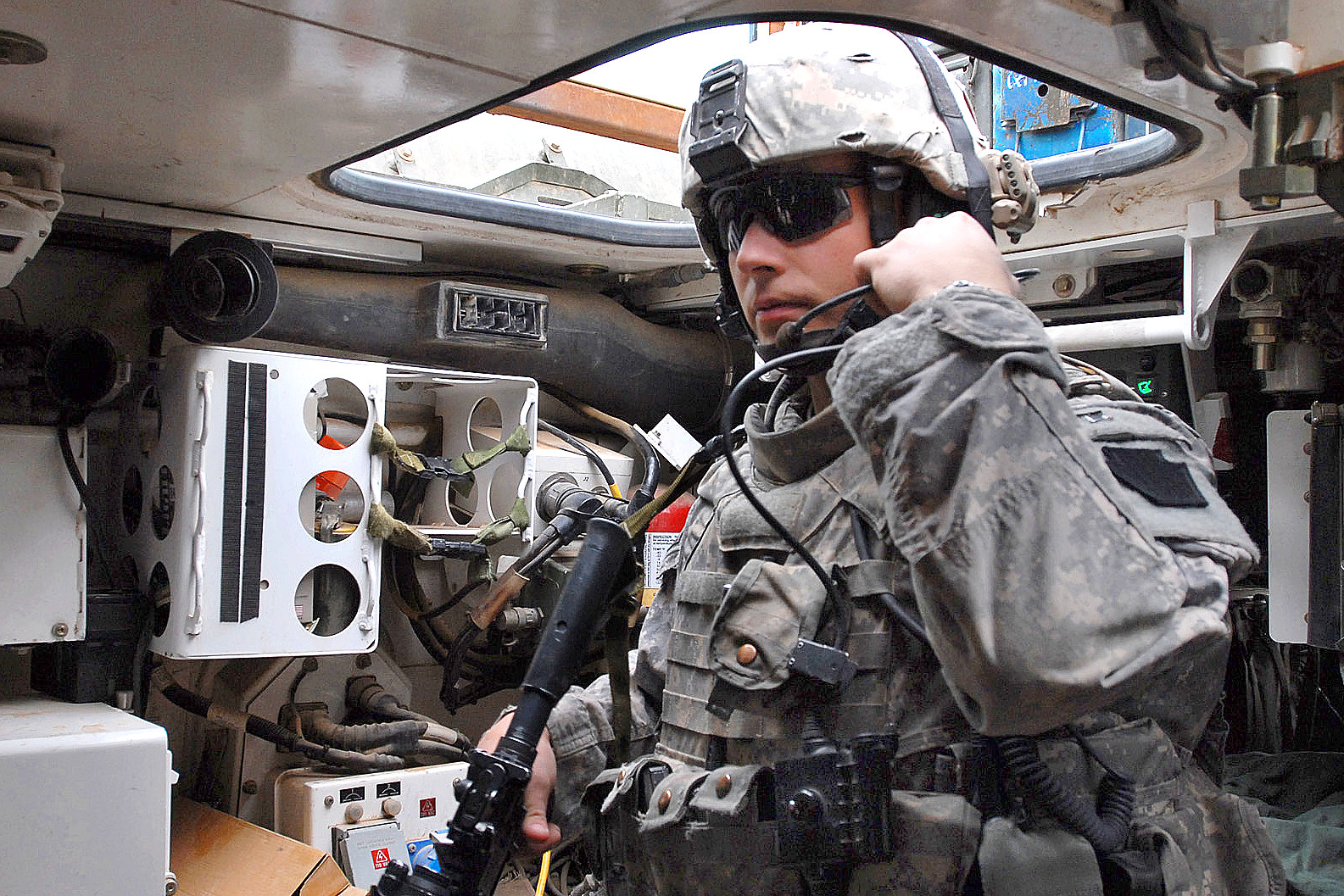

Topic Objective
Develop a Device-to-Device (D2D) squad-level communication platform that uses direct communications without network assistance of a radio access network (RAN). The D2D platform shall implement a cognitive agent controlling jamming mitigation strategies in contested electronic contested environments to provide increased resiliency and lethality for dismounted soldiers.
Description
The current state of the art for dismounted soldier communications is the adoption of commercial wireless waveforms (e.g., IEEE 802.11x, LTE) or existing tactical radios. In the case of commercial wireless waveforms, the waveform provides high bandwidth throughput and scalability. However commercial wireless waveforms are not developed to operate in electronic contested environments (i.e., Electronic Warfare). In the case of tactical radio waveforms, bandwidth throughput is minimal in comparison to commercial bandwidth speed. It does not support high bandwidth services or electronic warfare resiliency at the dismounted soldier level. In both cases, commercial and tactical radios, neither supports an evolving threat matrix or information-driven decision-making. Therefore, a solution is required that combines high-speed bandwidth throughput (i.e., commercial waveform) and resiliency in electronically contested environments.
The Offeror is required to provide an innovative solution that encompasses commercial high bandwidth and scalability. Some of these innovative solutions could be LTE-A, an intelligent cognitive agent, power-efficiency, and jamming mitigation electronics in a lightweight form-factor for dismounted operations. The following Key Performance Indicators (KPIs) for the said solution is below:
Phase I
The Offeror shall prepare and deliver a feasibility study at the end of phase 1. The feasibility study shall contain a proposed design concept, and implementation of a dismounted D2D communication platform based on system description and KPIs discussed and outlined in the description section. The proposed design concept and implementation shall be substantiated through modeling/simulation or other analytic means. When presenting modeling/simulation or analytic outcomes in the feasibility study, the offer shall include assumptions, caveats, and test data used substantiate conclusion(s) in the feasibility study.
Phase II
The Offeror shall provide 8-10 operational prototypes and demonstrate functionality at the end of phase 2. The network communication test scenarios shall consist of the following:
Phase III
The Offeror shall demonstrate the Dismounted D2D Communication Platform with a limited number of nodes that autonomously forms a network, processes Voice, C2, SA, and Video data traffic in support of dismounted soldiers. In terms of commercialization, the communications technology developed through this SBIR can be readily used in the IoT (Internet of Things) commercial market space. Several areas of the IoT include sensor networking and management, data off-loading for LTE (Long-Term Evolution) networks, and Smart Grid Communications.
Submission Information
To submit full proposal packages, and for more information, visit the DSIP Portal.

References:
Liebhart, R. (2015). LTE for public safety. Chichester: Wiley-Blackwell.
Mumtaz, S., & Rodriguez, J. (2014). Smart Device to Smart Device Communication. Cham: Springer International Publishing.
[SPEC] 3GPP TR 22.803 – Feasibility study for Proximity Services (ProSe). (n.d.). Retrieved from https://itectec.com/archive/3gpp-specification-tr-22-803/.
Itectec.com. (2019). [SPEC] 3GPP TS 23.303 – Proximity-based services (ProSe); Stage 2 – iTecTec. [online] Available at: https://itectec.com/archive/3gpp-specification-ts-23-303/ [Accessed 2 Nov. 2019].
[SPEC] 3GPP TR 36.843 – Study on LTE device to device proximity services; Radio aspects – iTecTec. (2014). Retrieved November 2, 2019, from https://itectec.com/archive/3gpp-specification-tr-36-843/
Topic Objective
Develop a Device-to-Device (D2D) squad-level communication platform that uses direct communications without network assistance of a radio access network (RAN). The D2D platform shall implement a cognitive agent controlling jamming mitigation strategies in contested electronic contested environments to provide increased resiliency and lethality for dismounted soldiers.
Description
The current state of the art for dismounted soldier communications is the adoption of commercial wireless waveforms (e.g., IEEE 802.11x, LTE) or existing tactical radios. In the case of commercial wireless waveforms, the waveform provides high bandwidth throughput and scalability. However commercial wireless waveforms are not developed to operate in electronic contested environments (i.e., Electronic Warfare). In the case of tactical radio waveforms, bandwidth throughput is minimal in comparison to commercial bandwidth speed. It does not support high bandwidth services or electronic warfare resiliency at the dismounted soldier level. In both cases, commercial and tactical radios, neither supports an evolving threat matrix or information-driven decision-making. Therefore, a solution is required that combines high-speed bandwidth throughput (i.e., commercial waveform) and resiliency in electronically contested environments.
The Offeror is required to provide an innovative solution that encompasses commercial high bandwidth and scalability. Some of these innovative solutions could be LTE-A, an intelligent cognitive agent, power-efficiency, and jamming mitigation electronics in a lightweight form-factor for dismounted operations. The following Key Performance Indicators (KPIs) for the said solution is below:
Phase I
The Offeror shall prepare and deliver a feasibility study at the end of phase 1. The feasibility study shall contain a proposed design concept, and implementation of a dismounted D2D communication platform based on system description and KPIs discussed and outlined in the description section. The proposed design concept and implementation shall be substantiated through modeling/simulation or other analytic means. When presenting modeling/simulation or analytic outcomes in the feasibility study, the offer shall include assumptions, caveats, and test data used substantiate conclusion(s) in the feasibility study.
Phase II
The Offeror shall provide 8-10 operational prototypes and demonstrate functionality at the end of phase 2. The network communication test scenarios shall consist of the following:
Phase III
The Offeror shall demonstrate the Dismounted D2D Communication Platform with a limited number of nodes that autonomously forms a network, processes Voice, C2, SA, and Video data traffic in support of dismounted soldiers. In terms of commercialization, the communications technology developed through this SBIR can be readily used in the IoT (Internet of Things) commercial market space. Several areas of the IoT include sensor networking and management, data off-loading for LTE (Long-Term Evolution) networks, and Smart Grid Communications.
Submission Information
To submit full proposal packages, and for more information, visit the DSIP Portal.
References:
Liebhart, R. (2015). LTE for public safety. Chichester: Wiley-Blackwell.
Mumtaz, S., & Rodriguez, J. (2014). Smart Device to Smart Device Communication. Cham: Springer International Publishing.
[SPEC] 3GPP TR 22.803 – Feasibility study for Proximity Services (ProSe). (n.d.). Retrieved from https://itectec.com/archive/3gpp-specification-tr-22-803/.
Itectec.com. (2019). [SPEC] 3GPP TS 23.303 – Proximity-based services (ProSe); Stage 2 – iTecTec. [online] Available at: https://itectec.com/archive/3gpp-specification-ts-23-303/ [Accessed 2 Nov. 2019].
[SPEC] 3GPP TR 36.843 – Study on LTE device to device proximity services; Radio aspects – iTecTec. (2014). Retrieved November 2, 2019, from https://itectec.com/archive/3gpp-specification-tr-36-843/
